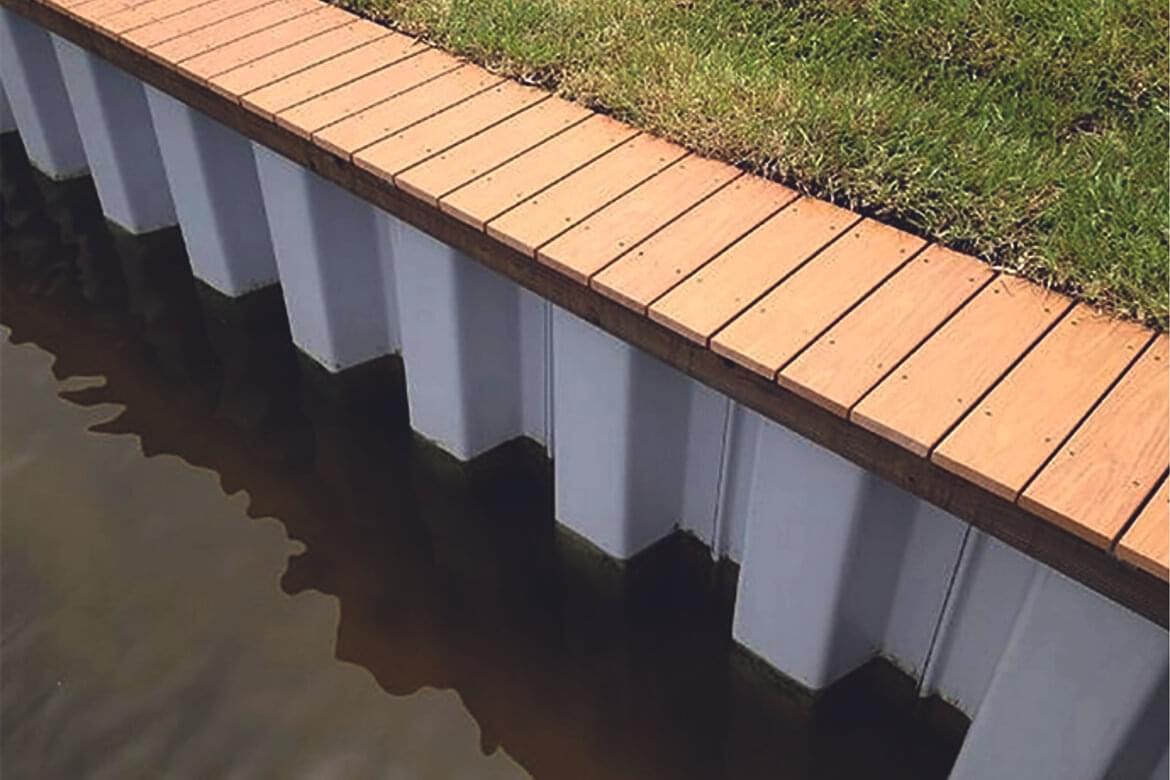Discovering the Various Uses of Bulkhead Frameworks in Modern Design
Bulkhead frameworks play a considerable function in contemporary style, offering both functional and visual functions. They can define spaces, enhance storage space solutions, and improve lighting. In commercial settings, they serve as prime focus that mirror brand identity - Bulkhead on Lake Livingston. Additionally, their integration typically supports sound administration and lasting techniques. Recognizing the complete extent of their applications exposes much regarding modern design fads and customer experience. What innovative uses of bulkheads might emerge in the future?
Specifying Bulkhead Structures
Bulkhead frameworks play an important function in modern design, working as vital components in numerous building designs. These structures are usually specified as increased ceilings or systems, usually utilized to conceal mechanical systems, circuitry, or pipes. Bulkheads can be located in both industrial and household settings, where they give a seamless mix of performance and looks. Their design can incorporate lights components and other attractive elements, enhancing the overall visual appeal of a room.
Generally constructed from products such as metal, timber, or drywall, bulkheads can be personalized to fit the architectural design and requirements of the building (Bulkhead on Lake Livingston). They offer not just to hide unpleasant framework however additionally to develop specified zones within open areas. By managing the flow of an area, bulkheads add to the spatial company, making them a considerable facet of modern architectural method. Consequently, their interpretation envelops both useful and visual dimensions
Practical Applications in Residential Layout
Bulkhead structures play a crucial role in property layout by promoting space optimization methods that make best use of functional locations. Additionally, they add aesthetic style components that boost the aesthetic allure of living rooms. In addition, these structures supply vital structural support remedies, making sure the stability and safety and security of the home.
Room Optimization Techniques
As contemporary household layouts progressively prioritize efficient use space, innovative approaches arise to take full advantage of functionality without sacrificing aesthetics. One noticeable strategy involves the combination of bulkhead structures, which can define locations while giving vital storage space options. These frameworks can be employed to develop upright storage space devices that boost both organization and access. Furthermore, multi-functional furnishings, such as foldable tables and convertible couches, enhances bulkhead styles, enabling areas to adjust to varying needs. Open up layout even more enhance spatial circulation, urging adaptability in use. Integrating integrated shelving and recessed lighting within bulkheads additionally adds to a structured setting, ensuring that fully of space is used effectively and harmoniously within the general style.
Visual Layout Elements

Structural Assistance Solutions
In modern-day household style, an effective architectural assistance option is essential for preserving the honesty of spaces while enhancing format and capability. Bulkhead frameworks play a considerable role in this situation, functioning as both assistance and dividing components. They can conceal mechanical systems, such as plumbing and electric circuitry, while providing reinforcement to the ceiling and floor systems. By strategically placing bulkheads, architects can create defined areas within open flooring strategies, enhancing usability without jeopardizing architectural stability. In addition, these structures can suit illumination components, adding to both visual appeals and functionality. To sum up, bulkhead structures are indispensable in residential style, providing flexible assistance remedies that improve both the performance and visual allure of living spaces.
Enhancing Visual Appeals in Business Rooms
When business rooms embrace cutting-edge bulkhead structures, they not only specify physical boundaries but additionally considerably improve the total visual appeals of the setting. These architectural aspects work as aesthetic prime focus, attracting attention and creating a feeling of intrigue. By incorporating varied materials such as glass, wood, or steel, bulkheads can mirror a brand's identification and goal, adding to a cohesive layout.
The critical placement of bulkheads can adjust light and darkness, adding deepness and dimension to or else flat areas. This interaction can transform an industrial area right into an inviting environment, urging customer engagement. Furthermore, using shade and appearance in bulkhead design can stimulate specific emotions, boosting the overall consumer experience. Inevitably, the thoughtful integration of bulkhead structures elevates the aesthetic charm of industrial rooms, making them not just functional however likewise visually charming, consequently fostering a long-term impact on visitors.
Acoustic Performance and Noise Monitoring
Efficient acoustic efficiency plays a crucial duty in modern design, especially within industrial spaces where sound monitoring is vital. Bulkhead frameworks can greatly improve acoustic high qualities by absorbing sound, decreasing reverberation, and mitigating sound transfer in between locations. These features are especially helpful in atmospheres such as movie theaters, dining establishments, and offices, where clear communication and an enjoyable auditory experience are paramount.
The tactical placement and layout of bulkheads can aid produce sound-buffer areas, pop over to these guys effectively isolating loud areas from quieter ones. Products made use of in bulkhead construction, such as soft coatings and acoustic panels, add to their sound-dampening capabilities. Additionally, the consolidation of bulkheads enables the assimilation of sound-absorbing aspects without endangering visual appeal. By resolving acoustic performance, engineers can develop unified atmospheres that enhance convenience, enhance customer experience, and promote performance, making bulkheads a vital element in the design of contemporary commercial areas.
Incorporating Bulkheads for Reliable Space Utilization
Typically overlooked, the combination of bulkheads in building style can significantly boost room utilization in contemporary structures. These architectural aspects offer multiple practical functions, offering a way to hide mechanical systems, electrical wiring, and plumbing without endangering aesthetics. By tactically placing bulkheads, architects can create defined locations within open flooring plans, therefore assisting in better company and circulation.
Bulkheads can incorporate storage space options and lighting functions, making the most of the functionality of otherwise thrown away upright room. In domestic setups, they might define zones such as kitchens or living locations, while in commercial areas, they can boost the performance of layouts by plainly noting pathways and job areas.
Ultimately, the thoughtful combination of bulkheads contributes to an extra visually enticing and well organized atmosphere, allowing for adaptable spaces that can develop with the demands of their residents. This approach not just maximizes area however additionally promotes a more unified communication between type and function.
Bulkheads in Public Style

Building Visual Enhancements
While lots of architectural elements purpose for functionality, bulkheads in public style offer a dual objective by improving aesthetic charm. These frameworks frequently produce visual rate of interest with their style, integrating seamlessly with bordering aspects. By employing numerous materials, appearances, and shades, bulkheads can contribute to a distinct identification for public spaces, such as flight terminals, galleries, and libraries. Their tactical positioning assists to define locations, directing visitors while adding depth to the general design. Additionally, bulkheads can highlight illumination, producing vibrant ambiences that alter throughout the day. This aesthetic enhancement not only boosts the visitor experience however likewise cultivates a local color, making bulkheads a vital factor to consider in modern-day public architecture. In general, bulkheads symbolize the fusion of type and function.

Structural Support Solutions
As architects seek ingenious means to enhance the architectural integrity of public areas, bulkheads emerge as vital elements in the style and construction process. These frameworks provide vital assistance, particularly in locations based on heavy foot traffic or vibrant loads. By distributing weight uniformly, bulkheads help protect against structural failing while allowing for flexible design alternatives. In big venues, such as stadiums and convention facilities, bulkheads are often incorporated into the general architectural framework, making sure security and safety and security. In addition, they can help with the consolidation of energies and mechanical systems, adding to the performance of area usage. Inevitably, bulkheads stand for an essential service in modern-day public architecture, strengthening both functionality and safety in community-focused atmospheres.
Environmental Defense Measures
Incorporating environmental management procedures into public architecture has come to be significantly essential as metropolitan developers prioritize sustainability alongside structural support. Bulkhead structures serve a twin purpose hereof, functioning as barriers versus erosion and flooding while simultaneously boosting the aesthetic appeal of urban landscapes. Their style frequently consists of all-natural elements such as vegetation, which can boost air high quality and offer habitats for wild animals. Additionally, bulkheads can be crafted with absorptive materials that enable water absorption, minimizing runoff and advertising groundwater recharge. This combination of ecological considerations not just preserves the atmosphere but likewise fosters community strength versus environment modification. By using bulkheads successfully, architects add to lasting metropolitan development that straightens with modern ecological objectives.
Future Patterns in Bulkhead Layout
Arising fads in bulkhead design reflect a growing focus on sustainability, innovation, and performance in contemporary design. Developers are significantly incorporating environmentally friendly materials, such as recycled composites and bioplastics, to minimize ecological impact. In enhancement, the assimilation of wise technology is ending up being widespread, allowing bulkheads to offer multi-functional functions, including energy storage and climate control.
In metropolitan settings, modular bulkhead systems are obtaining grip, supplying versatility in design and convenience of installment. These systems can be adapted to numerous landscapes, permitting for effective space application. Furthermore, visual factors to consider are advancing; bulkheads are now being designed to improve visual charm, usually incorporating artistic elements that resonate with local society.
As environment durability ends up being a priority, future bulkhead layouts will likely prioritize flood defense and stormwater administration, making sure architectural stability while dealing with ecological difficulties. This shift symbolizes an alternative approach to style that meets both human requirements and eco-friendly duties.
Often Asked Concerns
What Products Are Generally Used for Bulkhead Building And Construction?
Common products for bulkhead building include concrete, steel, lumber, and composite materials. These click options supply resilience, architectural integrity, and resistance to ecological elements, making them appropriate for numerous applications in building and engineering tasks.
Exactly How Do Bulkheads Impact Structure Energy Efficiency?
Bulkheads improve building power efficiency by offering thermal insulation and decreasing air leak (Bulkhead on Lake Livingston). They assist preserve interior temperature levels, thereby lowering home heating and cooling down demands, inevitably bring about lower energy prices and improved environmental sustainability
Exist Any Kind Of Structure Codes Specific to Bulkhead Frameworks?
Yes, constructing codes specific to bulkhead frameworks exist, differing by location. These laws normally resolve safety and security, architectural integrity, and ease of access, guaranteeing that bulkheads meet required criteria for building and layout within an offered territory.
Can Bulkheads Be Quickly Customized or Eliminated Later On?
Bulkheads can often be modified or gotten rid of, relying on their design and building and construction. Such changes might require careful preparation and adherence to structure codes to assure structural integrity and safety are maintained throughout the process.
What Are the Expenses Linked With Mounting Bulkhead Frameworks?
The expenses connected with mounting bulkhead structures can vary considerably, normally influenced by materials, style complexity, and labor. Usually, costs range from modest to high, depending on the job's specific needs and location.
Bulkhead structures play an essential function in contemporary architecture, serving as essential parts in numerous building designs. Bulkhead structures play an essential duty in domestic design by assisting in area optimization techniques that maximize usable locations. Often neglected, the assimilation of bulkheads in building style can significantly enhance area use in contemporary buildings. As designers seek ingenious means to boost the architectural honesty of public rooms, bulkheads arise as important elements in the layout and building procedure. The costs linked with mounting bulkhead frameworks can differ considerably, commonly affected by products, style Visit Your URL complexity, and labor.